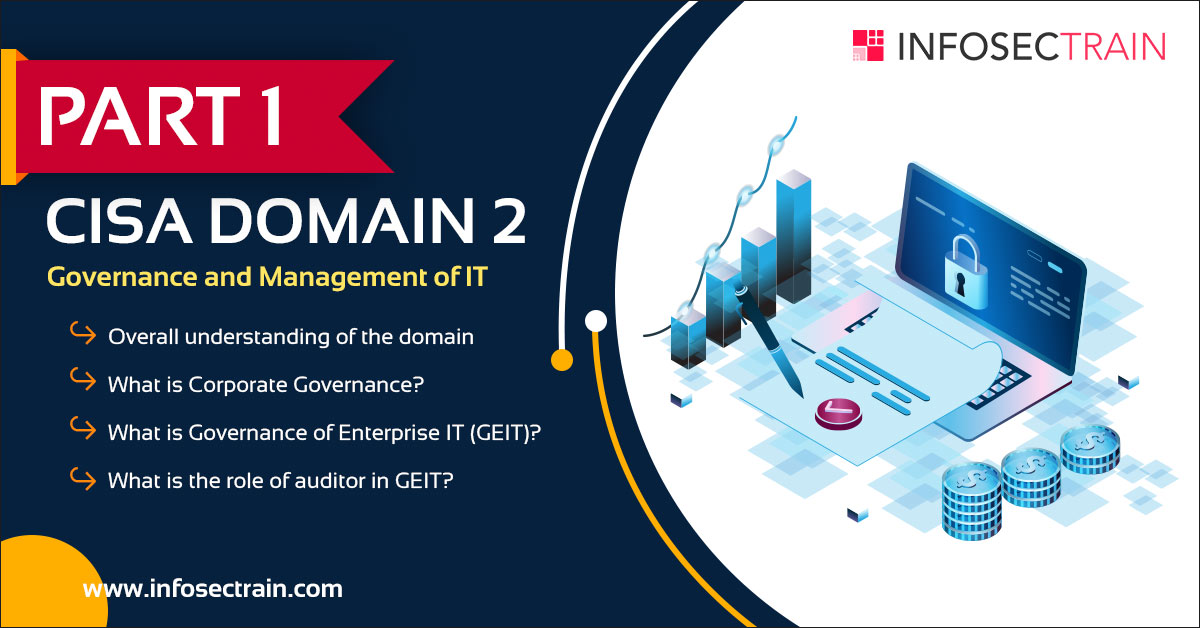PART 1 – CISA Domain 2 – Governance and Management of IT
This article covers –
- Overall understanding of the domain
- Important concepts to focus on from exam point of view
The article is split into 5 parts as below:
-
- Part 1 – Corporate Governance, Governance of Enterprise IT (GEIT), Auditor’s role in GEIT
- Part 2 – IT Balanced Score Card (BSC), IT Governing Committee (IT Strategy and Steering committee), Maturity and process improvement models
- Part 3 – Risk Management, Human Resource Management, Sourcing Practices
- Part 4 – Information Security – Roles and Responsibilities, Business Continuity Planning (BCP), Business Impact Analysis (BIA)
- Part 5 – Classification of Systems and criticality analysis, Components of Business Continuity Planning (BCP), Plan Testing.

PART 1 – CISA Domain 2 – Governance and Management of IT
-
-
- Overall understanding of the domain
- What is Corporate Governance?
- What is Governance of Enterprise IT (GEIT)?
- What is the role of auditor in GEIT?
-
- Knowledge of the organization’s technology direction and IT architecture and their implications for setting long-term strategic directions
- Knowledge of the processes for the development, implementation and maintenance of IT strategy, policies, standards and procedures
- Knowledge of the use of capability and maturity models
- Knowledge of process optimization techniques
- Knowledge of IT resource investment and allocation practices, including prioritization criteria (e.g., portfolio management, value management, personnel management
- Knowledge of IT supplier selection, contract management, relationship management and performance monitoring processes including third party outsourcing relationships
- Knowledge of enterprise risk management (ERM)
- Knowledge of practices for monitoring and reporting of controls performance (e.g., continuous monitoring, quality assurance [QA])
- Knowledge of quality management and quality assurance (QA) systems
- Knowledge of practices for monitoring and reporting of IT performance (e.g., balanced scorecards [BSCs], key performance indicators [KPIs])
- Knowledge of business impact analysis (BIA)
- Knowledge of the standards and procedures for the development, maintenance and testing of the business continuity plan (BCP)
- Knowledge of procedures used to invoke and execute the business continuity plan and return to normal operations
Important concepts from exam point of view:
|
1.Corporate Governance: |
- It is a system by which entity is controlled and directed
- Set of responsibilities and practices who provide strategic directions, thereby ensuring that
- Goals are achievable,
- Risk are properly addressed and
- Organizational resources are properly utilized
- Involves a set of relationships between a company’s management, its board, its shareholders and other stakeholders
Points to remember:
|
|
2.Governance of Enterprise IT (GEIT): |
- GEIT is one of the domains of Corporate governance
- GEIT is a system in which all stakeholders, including the board, senior management, internal customers and departments such as finance, provide input into the decision-making process.
- GEIT is the responsibility of the board of directors and executive management.
- Purposes of GEIT are:
- to direct IT endeavors to ensure that IT performance meets the objectives of aligning IT with the enterprise’s objectives and the realization of promised benefits
- enable the enterprise by exploiting opportunities and maximizing benefits
- IT resources should be used responsibly, and IT-related risk should be managed Appropriately
- Key element of GEIT is the alignment of business and IT, leading to the achievement of business value.
- Examples of GEIT includes the following:
- COBIT 5 is developed by ISACA, which includes five principles, five domains, 37 processes and 210 practices
- The International Organization for Standardization (ISO)/International Electro-technical Commission (IEC) 27001 (ISO 27001) – provides guidance to organizations implementing and maintaining information security programs.
- The Information Technology Infrastructure Library (ITIL) was developed by the UK Office of Government Commerce (OGC)
- ISO/IEC 38500:2008 Corporate governance of information technology
- ISO/IEC 20000 is a specification for service management that is aligned with ITIL’s service management framework
Points to remember:
|
|
3.Auditor’s Role in Governance of Enterprise IT (GEIT): |
- To provide leading practice recommendations to senior management to help improve the quality and effectiveness of the IT governance initiatives implemented.
- Helps ensure compliance with GEIT initiatives implemented within an organization
- continuous monitoring, analysis and evaluation of metrics associated with GEIT initiatives require an independent and balanced view to ensure a qualitative assessment that subsequently facilitates the qualitative improvement of IT processes and associated GEIT initiatives
- To check on alignment of the IT function with the organization’s mission, vision, values, objectives and strategies
- To ensure compliance with legal, environmental, information quality, fiduciary, security and privacy requirements



 1800-843-7890 (India)
1800-843-7890 (India) 
